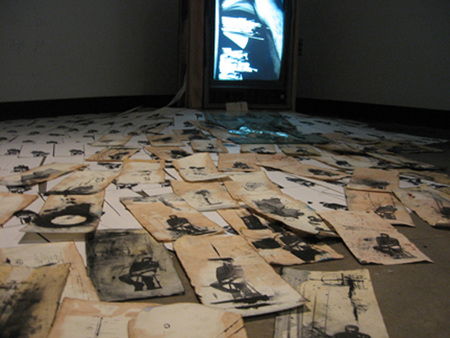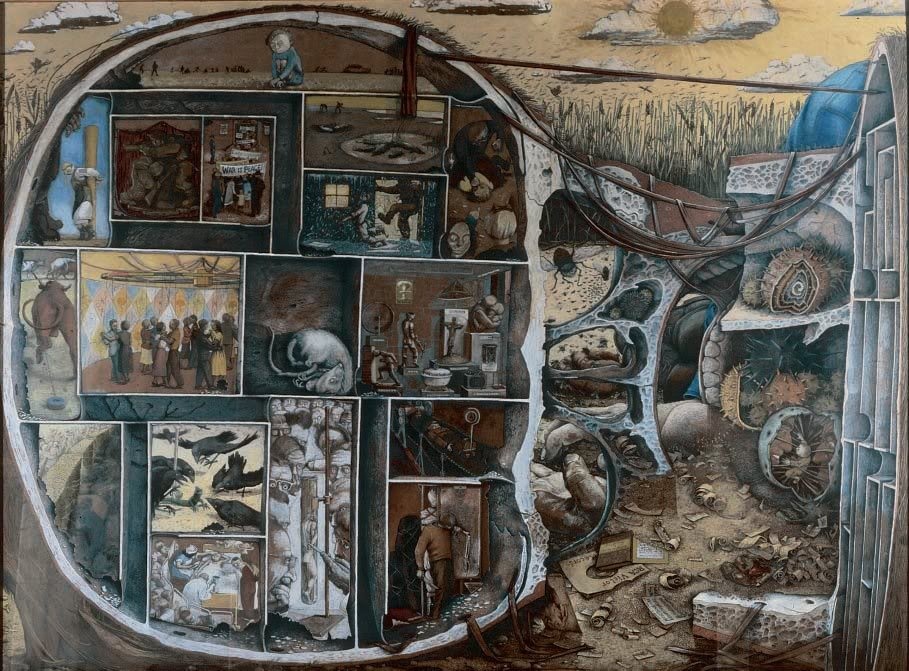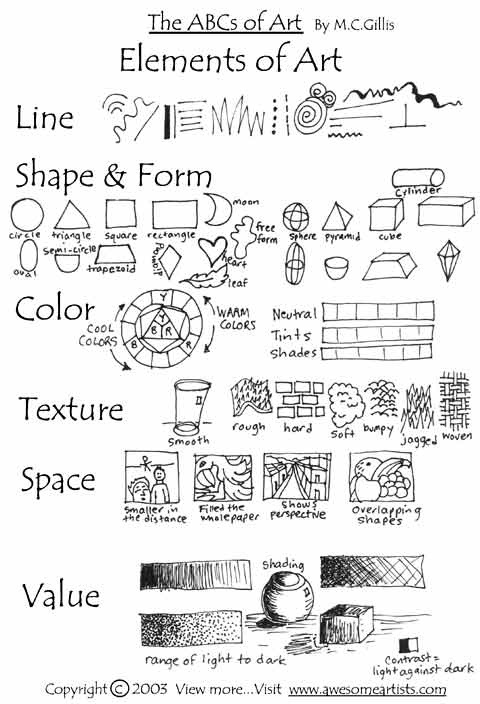 We have begun two new units at the same time. Why? Because one required more thought at the beginning and the other is a quick assignment, meant to be experimental and fun.
The larger assignment is PERSONAL CHOICE art piece. Please see the attached handout for the nitty gritty. Essentially, I am asking you to compose a VISUAL PROPOSAL for a work based on a previous work of art you have created, either this year or in years past. This does not have to be a polished work, it could be a sketchbook assignment or work completed in grade 5!
In this proposal, you are to include the following:
1) Name and description of previously completed inspiration artwork (with photo/sketch of work)
2) Clearly outline the main concepts for your new artwork.
3) Explain the methods, techniques and design principles you plan to use.
4) Create a careful drawing of your artwork idea.
5) Once your proposal has been approved, please bring needed materials or let me know what materials you will need, and begin your artwork in class.
PROPOSAL DUE DATE: MONDAY, DECEMBER 10
 | vav_3m1_4m1_personal_choice_proposal.pdf | | File Size: | 43 kb | | File Type: | pdf |
Download File
 The shorter assignment is one called Artist Trading Cards.
Artist Trading Cards began in the late 1990s when a Swiss artist decided it was a great idea to collect art internationally like adults and children collect hockey cards.
You each received a plastic card collecting sleeve with 9 compartments. and nine pieces of card stock (1 1/2 x 3 1/2 inches).
You don't have to use the paper, you can work on cloth, wood, metal, water colour paper, plastic or whatever suits your fancy, so long as the dimensions fit the sleeve.
You can work in whatever media you wish. Think of watercolour, prints, embroidery, collage, acrylic on canvas, wire sculpture, etc. If you create a print, you can have 9 editions; related art work (similar theme) would be a series; and individual art work would be originals. I encourage you to use a variety of techniques and to think outside the box. This is your opportunity to experiment!
Please watch the attached PowerPoint presentation for inspiration.
Please look at these websites for further information. The first one is the actual Swiss website for the ATC movement. And a Toronto site for exchanging Artist Trading Cards, on the 3rd Wednesday of every month at the Gladstone Hotel on Queen Street West at Dufferin Street. I will post the handout later today.
HAVE FUN!
I spoke with most of you Thursdsay and Friday, and there is were a lot of fantastic ideas floating around. Here are a few images from the internet to help you along with the 3 dimensional part. Remember, the 3D aspect doesn't necessarily have to be part of your flat work (coming out of it, for example). It can also be part of the display --the environnment-- of the piece.
The work above, by David Donovan, 2007, depicts obsessive compulsion.
Yayoi Kusama, undated, untitled work. She struggles with obsessivie compulsion.
William Kurelek, The Maze, 1953. He dealt with depression all his life.
 | vav_3m14m1_mental_health_awareness_campaign_commission.pdf | | File Size: | 218 kb | | File Type: | pdf |
Download File
There were many absences, but class must go on. Please work on attendance, especially those of you who are having a hard time catching up!
Today we looked the the following PowerPoint presentation on Mental Illness in art. We looked at the work of artists who are mentally ill as well as those artists who created works depicting the mentally ill. Please make a note of the artists in the PowerPoint as you will need to reference a work of art in your preliminary art work.
 | art_and_the_experience_of_mental_illness.pptx | | File Size: | 2511 kb | | File Type: | pptx |
Download File
i also distributed the Assignment Handout, outlining the process work required for the final work of art. Please read it carefully, I have attached it below. Essentially, you are to create a work of art on your selected Mental Illness, in which the experience of the illness is portrayed. You can choose any medium you would like, to create your artwork. My only stipulation is that there be a three dimensional component to it.
OOOPS! I just realized I left the handout at school and didn't save it on my home computer. I will upload it tomorrow! In the meantime, pick a mental illness, research it, sketch your initial impression of the mental illness and pick a work of art, either looked at in the PowerPoint above or found on your own, that could reflect your chosen mental illness. Remember, using specific Elements of Art and Principles of Design effectively can successfully recreate any state of mind.
Below are the Elements of Art and Principles of Design to help you in creating an effective work!
 We watched the following PowerPoint presentation in class about the different categories of mental illnesses. The overarching conclusion is that although mental illness is genetic, trauma, drugs and other external factors can enhance or bring about the symptoms.
We also discusses the power of the arts. A common proverb states: "a picture says a 1000 words". Artists can express with one work so much more that what can be written into volumes. Art reaches the critical masses: those who are illiterate, those who can not see to read, those who have little time can all benefit from a work of art that says all. In order to be potent, the artist needs to be educated on the theme he/she is working with, which is why we are looking more deeply into the condition of Mental Illness.
Once you have viewed the PowerPoint, select a Mental Illness and complete the research chart. You will use this information to create your artwork as well as to compose your Artist Statement.
 | vav_3m1_4m1_mental_illness_research.pdf | | File Size: | 82 kb | | File Type: | pdf |
Download File
We are beginning a new unit on Mental Illness. In class we worked understanding what Mental Illness in a questionnaire and discussions. Please answer the attached questionnaire and double-check your answers against the answer key.  | mental_illness_fact_or_fiction.pdf | | File Size: | 78 kb | | File Type: | pdf |
Download File
 | fact_or_fiction_-_answer_key.pdf | | File Size: | 255 kb | | File Type: | pdf |
Download File
Some other interesting facts discussed in class, from the CAMH website:
Factors that may contribute to the development of mental illness: Discussion guide
Although there is currently no agreement about the exact causes of mental illness, the following
factors are recognized as playing a role in the development of various mental illnesses:
Chemical imbalance
There is growing evidence that mental illness may be partially caused by a chemical imbalance
in the brain. Many people respond well to medications that address such an imbalance and
many of the symptoms of their illness are reduced or eliminated.
Substance use
There is no clear causal relationship between substance use and the development of mental
illness. People who have mental illness may use alcohol and other drugs to relieve some symptoms
of their illness. However, substance use may actually worsen symptoms and delay proper diagnosis
and treatment. There are also cases in which substance use has induced psychotic behaviour,
both because of the chemical effect of the drug and because the drug unmasks a pre-existing
mental illness.
Traumatic life events
Similar to substance use, traumatic life events can, in some instances, make people more vulnerable
to developing mental illness. Instead of recovering from a situational depression (e.g., grief following
the death of a loved one), some people may go on to develop a more profound, clinical depression.
Heredity
We are learning more about the role heredity plays in the development of mental illness.
Researchers have found that with certain diagnoses, the likelihood of a child developing a mental
illness is greater if one or both parents have a mental illness. Examples of diseases thought to
have a genetic component include schizophrenia, bipolar disorder, obsessive-compulsive disorder
and depression.
Other illnesses
People with conditions such as Alzheimer’s, Parkinson’s, dementia and brain damage (from
strokes or accidents) experience memory loss and confusion. People can also develop chronic
depression in conjunction with debilitating physical illness, or illnesses that alter their level
of functioning.
Some of the treatments involved:
TREATMENT OF MENTAL ILLNESS
Biological treatments
· medication
· electroconvulsive therapy (ECT).
Psychosocial Interventions
· psychotherapy
· self-help groups
· family support and involvement
· community supports.
The Centre for Addiction and Mental Health site (button below) can provide invaluable information on various Mental Illnesses.
Read the Surrealism PowerPoint attached below, to gain a better understanding about the works of art created during that period. Remember, Surrealism, like Expressionism, came about after the political and economical chaos of the early 20th century. Using the chart distributed, select one work of Art and write a critique about it. Once you have gathered the information, put it into a well-formed and edited paragraph. This was due Monday, November 19th.
 | surrealism_class_ppt.ppt | | File Size: | 3608 kb | | File Type: | ppt |
Download File
 | peer_art_critique_form.pdf | | File Size: | 101 kb | | File Type: | pdf |
Download File
I'm still waiting for a few people to submit their packages for the the Remembrance Day assignment. Don't forget to also include an artist statement!
During Term 1 you were to select 4 of the 10 sketchbook assignment suggestions attached in the handout below. Remember, these should be drawings/works of art that should take about an hour to complete. Your images should be detailed and carefully rendered. Your sketchbook is a place for your ideas, and often these assignments become a springboard for your future works of art.
If you have completed your first four selections, please pick 4 more sketchbook assignments to complete for the second term.
Ms. Zydron
 | vav_3m1_4m1_sketchbook.pdf | | File Size: | 157 kb | | File Type: | pdf |
Download File
Thank you to the 10 students who submitted their Remembrance Day Surrealist/Expressionist/Realist collage multi-media assingment on war. Please see the attachments below, if you have not been to class lately! The following file is the assignment handout. Our class was commissioned by the organizers of the Remembrance Day assembly, to create works of art capturing the solemn mood of the occasion.
 | vav_3m14m1_remembrance_day_commission.pdf | | File Size: | 59 kb | | File Type: | pdf |
Download File
 Gesture drawing explores the form and movement of an object in space. They are quick sketches concerned more about the pose of the figure, than the photographic realism of its form. Gesture sketches are completed in mere minutes (even seconds!). First, the line of action needs to be isolated, then the ovals of head, torso and hips added, followed by the pivot points of the limbs' joints. Once these have been established, a quick addition of volume completes the image. See the handout for a breakdown of these elements.
 | gesture_drawing.docx | | File Size: | 153 kb | | File Type: | docx |
Download File
TASK 1 was to first draw a gesture drawing from a figure in action in a magazine or newspaper (a sports figure is best for this). Cut the image out and draw directly onto it the lines of action (usually two), the ovals and pivot points. Draw the gesture image into your sketchbook.
TASK 2 was to draw a series of gesture drawings of the models posing on the website below. Use charcoal for best results. Make sure you mark your top 5 for me to evaluate. We looked at the following PowerPoint presentation on the artwork of the German Expressionists from the first few decades of the 20th Century. Expressionists depicted the emotional state of their subjects using primary colours. the feeling of movement, a non-photographic style and a sketchy rendering (either broad brushstrokes or sketchy line). Make note of the 4 characteristics of Expressionist art. TASK 3 was to superimpose the facial features of an emotional magazine subject (person) onto a gesture drawing. Using colour and pencil stroke, depict how that person feels. This should be done in charcoal, pastel, conte or chalk.  The next section of study focused on Surrealist Collage work. Surrealists liked to use three techniques, as seen in the work of Hannah Hoch in the image to the left:
1) Juxtaposition
2) Dislocation
3) Transformation
The handout and TASK below explains the process of creating a Surrealist Collage. Using three random words from an idea generator (button below), find at least 4 found images. You are to combine these with one drawing material and one painting medium to create a new image, expressing your words.
 | vav_3m1_4m1_surrealist_partner_collage.pdf | | File Size: | 304 kb | | File Type: | pdf |
Download File
 Your final sub-TASK in the process work for this unit was to create a realistic painted study of a red leaf. Realism or Formalism is the art movement in which the careful rendering of the subject was emphasized. This painting should look like a photograph. Brushstrokes should be smooth and small, all details present. Remember, mixing the complement into the original colour helps with creating realistic colours in your work! This work should be completed on a small square of illustration board.
You are now ready to research a war of your choice from the 20th century. There is a list of over 100 international conflicts since 1900 from which you can choose from, once you click on the button below. TASK: Pick one war that interests you as you will have to compose an artist statement, briefly connecting your work to the actual war. In your sketchbook, jot down a few facts to include in your written piece and print off 5-10 images of combat and destruction. Remember, these images will be part of your collage and you will use one from which to create your Expressionist drawing. These must be photographs! No paintings/cartoons. You should also pick an image of a poppy flower which you will use as your subject for the Realist painting. Again, this should be an image of the real flower, and not the poppy you wear on your lapel on Remembrance Day.
You are now ready to create your final mixed media artwork. You will use a piece of illustration board (45x65 cm) as your surface. For the painted areas use the higher quality (thicker) acrylics. Remember to contour cut the images you will use for your collage. Your Expressionist figure should be drawn (conte, chalk, charcoal, pastel, pencil crayon).
HAVE FUN!
|











 RSS Feed
RSS Feed